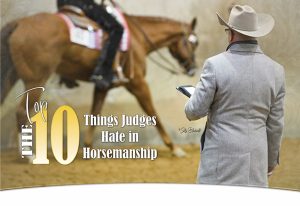Top Ten Things Judges Hate in Horsemanship
Click here to read the complete article
306 – May/June, 2022
When a horse and rider are entirely in tune with one another, a well-executed Horsemanship pattern looks effortless and almost magical. Cues are invisible and the flow is perfect. This type of pattern is easy for a judge to reward. However, there are some less than desirable Horsemanship habits that can easily lead to a negative score on a judges’ scoresheet.
With the help of three judges, we have compiled a list of the 10 things judges would rather not see in the Horsemanship pen. Together, these judges have over 60 years of combined experience and provide their suggestions for how to best address these common errors.
#1: Not Strategizing in Advance
The Error: A major part of Horsemanship comes before the judge’s nod, and that is studying the pattern and building a strategy that will show a horse and rider to their best advantage. The judging panel agrees that a major faux paus is when riders don’t spend enough time building a strategy ahead of time. Perhaps, a rider doesn’t consider their horse’s size in relation to the arena and pattern size, or fails to make note of marker placement when executing a transition.
“Visualizing your pattern and thinking through each maneuver and transition is imperative,” Ochetto says. “The five point penalty incurred for failing to execute a maneuver within 10 feet of the designated area happens all too often while riders are on pattern. That’s almost always due to lack of planning.”
Wells agrees. He says, “Cones are placed for a reason, as a beginning and end to each maneuver. What happens in between is totally at your discretion. It’s very hard to reward a maneuver when it’s been poorly planned or executed.”
The Fix: “When studying your pattern at the show, make sure you look at where the judges set their markers and look for specific focal points in the arena to best find a mark that can aid you as to where that specific maneuver is to be executed,” Ochetto says. “If you’re able to observe fellow riders prior to your pattern, that’s often helpful to better visualize your planned execution of the pattern.”
As a trainer and judge, Wells advises his clients to know the lay of the land. Simply put, that means choosing landmarks in the arena–such as a sign on a wall, or even an imaginary line in the dirt–to help with spacing and maneuver placement. “Observing the horses ahead of you can certainly help to inform your strategy and decisions, but someone always has to go first, so be sure to be confident in your own plan.”
“Patterns are getting more complicated. With patterns that have only a start cone and no others, failure to plan is an obvious error,” Briere says. “When someone goes in and doesn’t have a plan for how they’re going to execute, they’re not able to put together an entire, flowing performance. The best way to do that is to use your arena, know where the center is, transition in precise spots to avoid location penalties, and do it all with flow and confidence.”
So think through it all and plan well in advance. Know how far from a specific point you’ll ask for each transition, the distance from a cone that you need to stop to get a perfect turn, and whether your horse will hesitate if you ask for a lead change coming out of a circle. Think through it all and plan well in advance.
#2: Long Reins or Being Overbridled
Click here to read the complete article
306 – May/June, 2022











